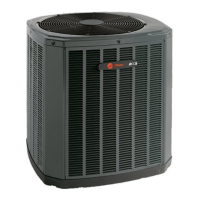|nsta||er's Guide
LIQUID LINE SERVICE VALVE
ROLLED EDGE TO
;TEM
CAP-_=.-
UNIT SIDE OF _ HEX HEADED
SERVICE VALVE VALVE SYSTEM
SERVICE
PORT
LIQUID LINE
CONNECTION
5. Do NOT allow uninsulated liquid line to come in direct
contact with bare gas line.
6. Precautions should be taken to avoid heat damage
to the pressure tap valve core during brazing. It is
recommended that the pressure tap port valve
core be removed and a wet rag wrapped around
the valve body.
NOTE:
Use care to make sure that no moisture enters pressure tap
port, while wet rag is being used.
NOTE:
Precautions should be taken to avoid heat damage to
basepan during brazing. It is recommended to keep the
flame directly off of the baeepan.
7. Use a Dry Nitrogen Purge and Brazing Alloy without
flux when brazing the field line to the copper factory
connection. Flow dry nitrogen into either valve pressure
tap port, thru the tubing and out the other port while
brazing.
8. Braze using accepted good brazing techniques.
LEAK CHECK
iMPORTANT:
Replace pressure tap port valve core before attaching hoses for
evacuation.
After the brazing operation of refrigerant lines to both the
outdoor and indoor units is completed, the field brazed
connections must be ehecked for leaks. Pressurize through
the serviee valve ports, the indoor unit and field refrigerant
lines with dry nitrogen to 350-400 psi. Use soap bubbles or
other leak-checking methods to see that all field joints are
leak-free! If not, release pressure; then repair!
SYSTEM EVACUATION
NOTE:
Since the outdoor unit has a refrigerant charge, the gas and
fiquid line valves must remain closed.
1. Upon completion of leak check, evacuate the refrigerant
lines and indoor coil before opening the gas and liquid
line valves.
2. Attach appropriate hoses from manifold gauge to gas
and liquid line pressure taps.
NOTE:
Unnecessary switching of hoses can be avoided and
complete evacuation of all lines leading to sealed system
can be accomplished with manifold center hose and
connecting branch hose to a cylinder of R-410A and
vacuum pump.
3. Attach center hose of manifold gauges to vacuum pump.
4. Evacuate until the micron gauge reads no higher than
350 microns.
5,
6,
7.
Close offvalve to vacuum pump and observe the micron
gauge. If gauge pressure rises above 500 microns in one (1)
minute., then evacuation is incomplete, or wstem has a leak.
If vacuum gauge does not rise above 500 microns in
one (1) minute, the evacuation should be complete.
Blank off vacuum pump and micron gauge, close
valves on manifold gauge set.
NOTE:
DO NOT VENTREFRIGERANTINTO THEATMOSPHERE.
NOTE:
A 3/16"Allen wrench is required to open liquid line service
valve. A 1/4" Open End or Adjustable wrench is required to
open gas line valve. A 3/4" Open End wrench is required to
take off the valve stem cap.
8. The liquid line shut-offvalve can now be opened. Remove
shut-off valve cap. Fully insert hex wrench into the stein
and backout counterclockwise until vane stem just touches
rolled edge (approximately five [5]turns) observing
WARNING statement on page 2. See Figure 3.
9. Replace liquid service pressure tap port cap and valve
stem cap. These caps MUST BE REPLACED to
prevent leaks. Replace valve stem cap and pressure tap
cap finger tight, then tighten an additional 116turn.
10.
11.
The gas valve can now be opened. Open the gas valve by
removing the shut-off valve cap and turning the valve
stem 1/4 turn counterclockwise, using 1/4" Open End or
Adjustable wrench. See Figures 4 and 5.
The gas valve is now open for refrigerant flow. Replace
valve stem cap to prevent leaks. Again, these caps
©
GAS LINE BALL SERVICE VALVE
CAP _._ J--| 114 TURN ONLY
COUNTERCLOCKWISE
FOR FULL OPEN
UNIT SIDE
OF VALVE
VALVE STEM
PRESSURE TAPPORT /
GAS LINE CONNECTION
@
GAS LINE SERVICE VALVE
CAP_ @ _
UNIT SIDE OF
SERVICE VALVE
ROLLED EDGE TO
CAPTIVATE STEM
HEXHEADED
VALVE SYSTEM
SERVICE_
PORT
/
GAS LINE
CONNECTION
18-AC51 D1-4 3

